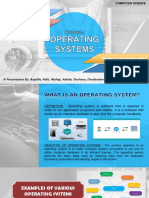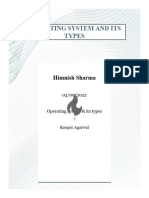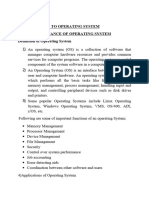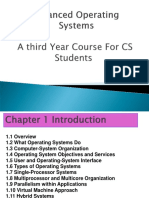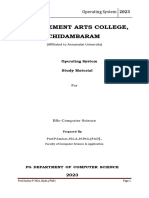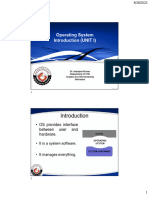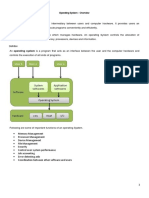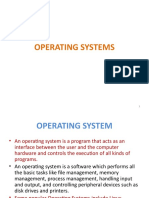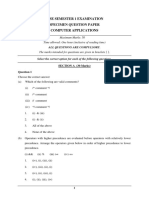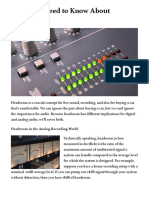16-02-2025
WHAT IS AN OPERATING SYSTEM?
• Operating system is a resource allocator eg. CPU time, memory
space, files storage space, input/output devices etc.
• Since there may be many, possibly conflicting, requests for
resources, the operating system must decide which requests are
allocated resources to operate the computer system fairly and
efficiently.
• An operating system is a control program. This program controls the
execution of user programs to prevent errors and improper use of
the computer.
• Operating systems exist because: they are a reasonable way to solve
the problem of creating a usable computing system.
Purposes
• To control the allocation and use of the computing system’s
resources among the various users and tasks, and
• To provide an interface between the computer hardware and the
programmer that simplifies and makes feasible the creation, coding,
debugging, and maintenance of application programs.
1
� 16-02-2025
Functions
• Should act as a command interpreter by providing a user friendly environment.
• Should facilitate communication with other users.
• Facilitate the directory/file creation along with the security option.
• Provide routines that handle the intricate details of I/O programming.
• Provide access to compilers to translate programs from high-level languages to
machine language
• Provide a loader program to move the compiled program code to the
computer’s memory for execution.
• Assure that when there are several active processes in the computer, each will
get fair and non-interfering access to the central processing unit for execution.
• Take care of storage and device allocation.
• Provide for long term storage of user information in the form of files.
• Permit system resources to be shared among users when appropriate, and be
protected from unauthorized or mischievous intervention as necessary.
TYPES OF OPERATING SYSTEMS
• Batch Processing Operating System
• Users submit jobs to a central place where these jobs are collected into a
batch, and subsequently placed on an input queue at the computer where
they will be run.
• The user has no interaction with the job during its processing.
• The computer’s response time is the turnaround time, and the results are
ready for return to the person who submitted the job.
2
� 16-02-2025
TYPES OF OPERATING SYSTEMS
• Time Sharing
• A computer provides computing services to several or many users
concurrently on-line.
• Here, the various users are sharing the central processor, the memory, and
other resources of the computer system in a manner facilitated, controlled,
and monitored by the operating system.
• The user, in this environment, has nearly full interaction with the program
during its execution.
• The computer’s response time may be expected to be no more than a few
second.
TYPES OF OPERATING SYSTEMS
• Real Time Operating System (RTOS)
• Designed to service those applications where response time is of the
essence in order to prevent error, misrepresentation or even disaster.
• Examples of real time operating systems are those which handle airlines
reservations, machine tool control, and monitoring of a nuclear power
station.
• The systems, in this case, are designed to be interrupted by external signals
that require the immediate attention of the computer system.
• These real time operating systems are used to control machinery, scientific
instruments and industrial systems.
• An RTOS typically has very little user-interface capability, and no end-user
utilities.
• A very important part of an RTOS is managing the resources of the
computer so that a particular operation executes in precisely the same
amount of time every time it occurs.
3
� 16-02-2025
TYPES OF OPERATING SYSTEMS
• Multiprogramming Operating System
• It is a system that allows more than one active user program (or part of user
program) to be stored in main memory simultaneously.
• Thus, it is evident that a time-sharing system is a multiprogramming system,
but note that a multiprogramming system is not necessarily a time-sharing
system.
• A batch or real time operating system could, and indeed usually does, have
more than one active user program simultaneously in main storage.
TYPES OF OPERATING SYSTEMS
• Multiprocessing System
• It is a computer hardware configuration that includes more than one
independent processing unit.
• The term multiprocessing is generally used to refer to large computer
hardware complexes found in major scientific or commercial applications.
4
� 16-02-2025
TYPES OF OPERATING SYSTEMS
• Networking Operating System
• It is a collection of physical interconnected computers.
• The operating system of each of the interconnected computers must
contain, in addition to its own stand-alone functionality,
• provisions for handing communication and
• transfer of program and data among the other computers with which it is connected.
• Network operating systems are not fundamentally different from single
processor operating systems.
• They obviously need a network interface controller and some low level
software to drive it, as well as programs to achieve remote login and remote
files access, but these additions do not change the essential structure of the
operating systems.
TYPES OF OPERATING SYSTEMS
• Distributed Operating System
• It consists of a number of computers that are connected and managed so that they
automatically share the job processing load among the constituent computers, or
separate the job load as appropriate particularly configured processors.
• Such a system requires an operating system which, in addition to the typical stand-
alone functionality, provides coordination of the operations and information flow
among the component computers.
• The networked and distributed computing environments and their respective
operating systems are designed with more complex functional capabilities.
• In a network operating system, the users are aware of the existence of multiple
computers, and can log in to remote machines and copy files from one machine to
another. Each machine runs its own local operating system and has its own user (or
users).
5
� 16-02-2025
TYPES OF OPERATING SYSTEMS
• Distributed Operating System
• A distributed operating system, in contrast, is one that appears to its users as a
traditional uni-processor system, even though it is actually composed of multiple
processors.
• In a true distributed system, users should not be aware of where their programs
are being run or where their files are located; that should all be handled
automatically and efficiently by the operating system.
• True distributed operating systems require more than just adding a little code to a
uniprocessor operating system, because distributed and centralized systems differ
in critical ways.
• Distributed systems, for example, often allow program to run on several processors
at the same time, thus requiring more complex processor scheduling algorithms in
order to optimize the amount of parallelism achieved.
TYPES OF OPERATING SYSTEMS
• Operating Systems for Embedded Devices
• As embedded systems (PDAs, cellphones, point-of-sale devices, VCR’s,
industrial robot control, or even your toaster) become more complex
hardware-wise with every generation, and more features are put into them
day-by-day, applications they run require more and more to run on actual
operating system code in order to keep the development time reasonable.
• Some of the popular OS are:
• Nexus’s Conix - an embedded operating system for ARM processors.
• Sun’s Java OS - a standalone virtual machine not running on top of any other OS;
mainly targeted at embedded systems.
• Palm Computing’s Palm OS - Currently the leader OS for PDAs, has many applications
and supporting companies.
• Microsoft’s Windows CE and Windows NT Embedded OS.

